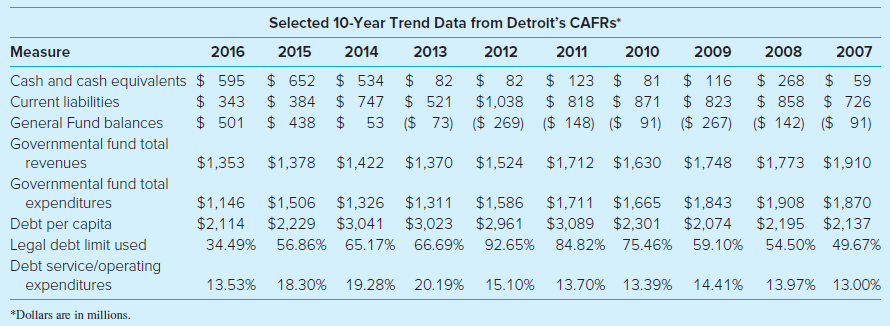Question:
For the past two editions of the textbook, this case has followed the financial condition of Detroit, Michigan. As this text goes to print, Detroit has emerged from bankruptcy and in accordance with Michigan Public Act 181 of 2014, it is currently monitored by the Detroit Financial Review Commission for compliance with the Plan of Adjustment. In the 2016 CAFR, Detroit indicates that its debt rating has actually been upgraded from the time the last edition of the textbook was published, when its debt had received a junk bond rating of Caa2 from Moody€™s. Currently the debt is rated as B2, which puts the uninsured debt in the below investment grade category. The audit of the 2015€“2016 financial reports, conducted by Plante and Moran, provided Detroit with an unmodified opinion. As discussed in the MD&A, Detroit is making progress toward a sounder financial footing. Bonded debt decreased by $5.8 billion in the fiscal year as a result of eliminated, restructured, and new debt associated with the bankruptcy restructuring.
Use the information from the table of selected 10-year trend data and the Detroit CAFR report for the year ended June 30, 201621 to complete this assignment. 
Required
a. Use Illustrations 10-3 and 10-4 to determine relevant ratios to construct from the above trend data. From the ratios you construct and the other trend data in the statistical section of the CAFR, evaluate the financial condition of Detroit as of June 30, 2016. Provide a brief write-up of your analysis.
b. Based on your analysis, do you agree with the auditor€™s unmodified report (i.e., you see nothing that would indicate a going-concern issue)?
c. After completing your trend analysis in part a and providing your opinion in part b, refer to the section entitled Analyzing Government-wide Financial Statements. At the end of that section, a number of warning indicators concerning fiscal distress are listed. Using indicators from that list, does your opinion in b change? Why or why not?
Transcribed Image Text:
Selected 10-Year Trend Data from Detroit's CAFRS* 2015 2014 2012 2016 2009 2008 Measure 2013 2011 2010 2007 82 $ 268 Cash and cash equivalents $ 595 Current liabilities General Fund balances Governmental fund total revenues Governmental fund total expenditures Debt per capita Legal debt limit used Debt service/operating expenditures $ 652 $ 384 $ 438 $ 534 $ 747 2$ $ 82 $1,038 $ 123 81 $ 116 $ 823 $ 59 $ $ 818 $ 871 53 ($ 73) ($ 269) ($ 148) ($ 91) ($ 267) ($ 142) ($ 91) $ 343 $ 501 $ 521 $ 858 $ 726 $ $1,773 $1,910 $1,353 $1,378 $1,422 $1,370 $1,524 $1,748 $1,712 $1,630 $1,506 $1,326 $1,311 $2,229 $3,041 $3,023 $1,843 $2,074 $1,908 $1,870 $2,195 $2,137 54.50% 49.67% $1,146 $1,586 $1,665 $1,711 $3,089 $2,301 $2,114 $2,961 34.49% 56.86% 65.17% 66.69% 92.65% 84.82% 75.46% 59.10% 18.30% 19.28% 20.19% 14.41% 13.70% 13.39% 13.97% 13.00% 13.53% 15.10% *Dollars are in millions.







